Operations
Here you will find answers to ICND 2 – Operation Questions
Question 1
Refer to the exhibit. The following commands are executed on interface fa0/1 of 2950Switch.
2950Switch(config-if)#switchport port-security
2950Switch(config-if)#switchport port-security mac-address sticky
2950Switch(config-if)#switchport port-security maximum 1
The Ethernet frame that is shown arrives on interface fa0/1. What two functions will occur when this frame is received by 2950Switch? (Choose two)
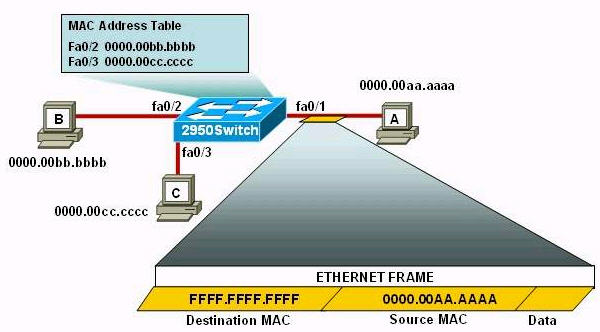
A – The MAC address table will now have an additional entry of fa0/1 FFFF.FFFF.FFFF.
B – Only host A will be allowed to transmit frames on fa0/1.
C – This frame will be discarded when it is received by 2950Switch.
D – All frames arriving on 2950Switch with a destination of 0000.00aa.aaaa will be forwarded out fa0/1.
E – Hosts B and C may forward frames out fa0/1 but frames arriving from other switches will not be forwarded out fa0/1.
F – Only frames from source 0000.00bb.bbbb, the first learned MAC address of 2950Switch, will be forwarded out fa0/1.
Answer: B D
Explanation:
The first command 2950Switch(config-if)#switchport port-security is to enable the port-security in a switch port.
In the second command 2950Switch(config-if)#switchport port-security mac-address sticky, we need to know the full syntax of this command is switchport port-security mac-address sticky [MAC]. The STICKY keyword is used to make the MAC address appear in the running configuration and you can save it for later use. If you do not specify any MAC addresses after the STICKY keyword, the switch will dynamically learn the attached MAC Address and place it into your running-configuration. In this case, the switch will dynamically learn the MAC address 0000.00aa.aaaa of host A and add this MAC address to the running configuration.
In the last command 2950Switch(config-if)#switchport port-security maximum 1 you limited the number of secure MAC addresses to one and dynamically assigned it (because no MAC address is mentioned, the switch will get the MAC address of the attached MAC address to interface fa0/1), the workstation attached to that port is assured the full bandwidth of the port.Therefore only host A will be allowed to transmit frames on fa0/1 -> B is correct.
After you have set the maximum number of secure MAC addresses for interface fa0/1, the secure addresses are included in the “Secure MAC Address” table (this table is similar to the Mac Address Table but you can only view it with the show port-security address command). So in this question, although you don’t see the MAC address of host A listed in the MAC Address Table but frames with a destination of 0000.00aa.aaaa will be forwarded out of fa0/1 interface -> D is correct.
Question 2
A network administrator must configure 200 switch ports to accept traffic from only the currently attached host devices. What would be the most efficient way to configure MAC-level security on all these ports?
A – Visually verify the MAC addresses and then telnet to the switches to enter the switchport-port security mac-address command.
B – Have end users e-mail their MAC addresses. Telnet to the switch to enter the switchport-port security mac-address command.
C – Use the switchport port-security MAC address sticky command on all the switch ports that have end devices connected to them.
D – Use show mac-address-table to determine the addresses that are associated with each port and then enter the commands on each switch for MAC address port-security.
Answer: C
Explanation:
(Please read the explanation of question 1 to understand the use of the “switchport port-security MAC address sticky”)
A and C can be used, but instead of writing all the MAC addresses of the devices associated with each port, we can ask the switch to learn all the MAC addresses of the associated devices automatically by the “switchport port-security mac-address sticky” command which will save much work for the administrator.
Question 3
Refer to the exhibit. What can he concluded from the output of the debug command?
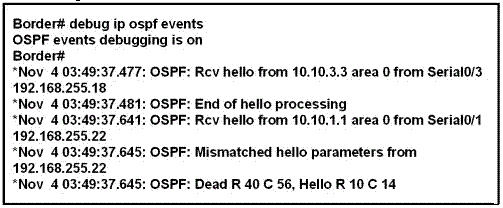
A – The output represents normal OSPF operation.
B – The interfaces of two OSPF routers connected to the Border router are in the same subnet.
C – The OSPF router connected to interface Serial0/1 has NOT formed a neighbor relationship with the Border router.
D – A router is connected to interface Serial0/3 of the Border router. The OSPF router ID of the connected router is the IP address of the connected interface.
Answer: C
Question 4
Refer to the exhibit. What does STATUS=ACTIVE refer to in the output of the show frame-relay pvc command?
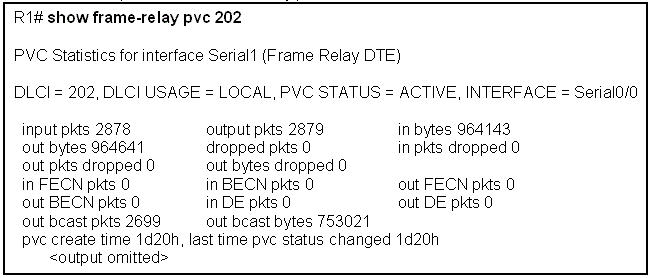
A – The PVC is experiencing congestion.
B – The Frame Relay switch is correctly programmed with the DLCI and is operational.
C – The router is actively broadcasting to establish a link to the Frame Relay switch.
D – The router is connected to the local Frame Relay switch, but not to the far end device.
Answer: B
Question 5
Refer to the graphic. Users on the Holyoke router are unable to access the intranet server attached to interface E0 of the Chicopee router. Inspection of the routing table of the Holyoke router shows that an entry for the Chicopee E0 network is missing. Which command will configure the Holyoke router with a path to the intranet server network?
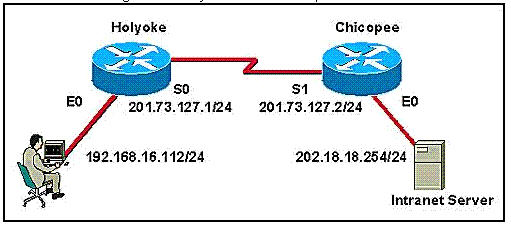
A – Holyoke(config)# ip host Chicopee 201.73.127.2
B – Holyoke(config)# ip host Chicopee 201.73.127.0 255.255.255.0
C – Holyoke(config)# ip network 202.18.38.0
D – Holyoke(config)# ip network 202.18.18.0 255.255.255.0
E – Holyoke(config)# ip route 202.18.18.0 255.255.255.0 201.73.127.2
F – Holyoke(config)# ip route 201.73.127.2 255.255.255.0 202.18.18.0
Answer: E
Question 6
Users have been complaining that their Frame Relay connection to the corporate site is very slow. The network administrator suspects that the link is overloaded. Based on the partial output of the Router#show frame relay pvc command shown in the graphic, which output value indicates to the local router that traffic sent to the corporate site is experiencing congestion?
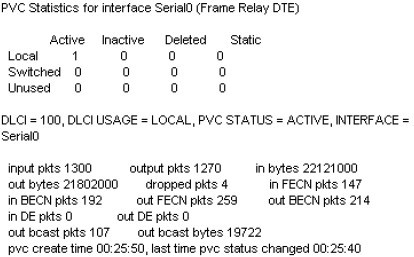
A.DLCI = 100
B.last time PVC status changed 00:25:40
C.in BECN packets 192
D.in FECN packets 147
E.in DE packets 0
Answer: C
Explanation
If one of the intermediate Frame Relay switches encounters congestion, it will set the BECN (Backward Error Congestion Notification) bit on packets being returned to the sending device and the FECN (Forward Error Congestion Notification) bit on the packets being sent to the receiving device.
A FECN tells the receiving device that the path is congested so that the upper layer protocols should expect some delay. The BECN tells the transmitting device that the Frame Relay network is congested and that it should “back off” to allow better throughput.
The DE (Discard Eligibility) bit is used to identify less important traffic that can be dropped during periods of congestion. DCE devices will discard frames with the DE bit set before discarding those that do not.
Question 7
Refer to the exhibit. Which of these statements correctly describes the state of the switch once the boot process has been completed?
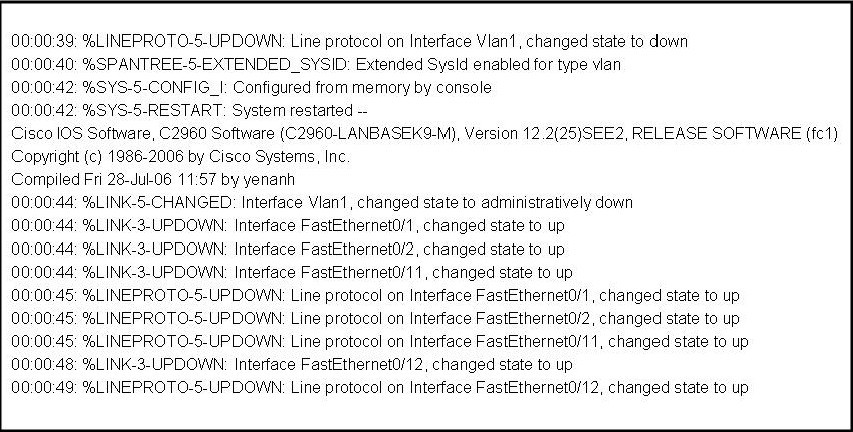
A. As FastEthernet0/12 will be the last to come up, it will be blocked by STP.
B. Remote access management of this switch will not be possible without configuration change.
C. More VLANs will need to be created for this switch.
D.The switch will need a different IOS code in order to support VLANs and STP.
Answer: B
Explanation
We don’t know the network topology so A is not correct.
A switch can operate without VLANs -> C is not correct.
This switch IOS supports VLAN because we can see VLAN 1 in the exhibit -> D is not correct.
In this case, VLAN 1 has been shutdown so we can’t remote access to this switch -> B is correct.


Had most of these today, passed. Barely passed.
are u sure q7 ‘s answer B , I see diifferent test answer is C
q 7. I saw the answer as C on the Mashti too. but i agree with B
I have some photozz from my exam.I can mail to human which potted it to this site.
Sorry for my poor English slavian2004@bk.ru
memet
Me too, I saw it as C, But I agree with B.
Took test 9/6 only saw Q1 on the test.
i only had Q1 in my test
Hi, everyone, anyone have How2pass dumps and lab/simlets, kindly send the link, I will take my ICND2 in two week. thanks
i will take icnd2 exam soon please help me to have some dumps and labs.
thanks you
i will take icnd2 exam soon please help me to have some dumps and labs.my e-mail is domagnie@yahoo.fr
thanks you
Hi 9tut!!
Got new question:
Which port is newly introduced in Rapid-PVST?
1. Learning
2. Listening
3. Discarding
4. Forwarding
Hi
inregards to question 7 . In pass4sure exams the correct answer is C …which does not even make sense .kindly can you explain why it could be C ? OR the pass4sure exam got it wrong
regards
@adish
It is “3. discarding”. Looks like you’re studying only dumps for the exam!
@Muhammad hammad
P4S is wrong. I googled the questions and many results show that B is the correct answer.
p4s is way wrong. maybe 6 identical questions on my test
@testICND2 failed
Study more! Dumps are just there to give you an idea of the exam. You have to know your stuff.
Regarding the 7 question i think the right answer is
“B. Remote access management of this switch will not be possible without configuration change.”
They just put the INTERFACE VL1 admin down, the vlan 1 is still on the switch, and the switch will be just fine will all ports in vlan 1.
Also answers from question 272 and 274 from ACME are wrong, but i will let you decide what is the right answer :).
Thx everyone, and 9tut.com for support.
Theos_1406 from Romania.
Sorry ACME is for CCNA not ICND.
Answer: B
Explanation
We don’t know the network topology so A is not correct.
A switch can operate without VLANs -> C is not correct.
This switch IOS supports VLAN because we can see VLAN 1 in the exhibit -> D is not correct.
In this case, VLAN 1 has been shutdown so we can’t remote access to this switch -> B is correct.
*****You have to look at the INFO given VLAN 1 is down so no you cannot have remote access to that vlan. However In order for vlan 1 to be down another vlan must have been established because vlan 1 is on by default. So therefore there is another active vlan on this device. But it left us to assume. So going by the info you have to go with C
@ I cant see B: Actually C is n’t a choice because if you check now using packet tracer or any simulator or the default vlan which is vlan 1 is by default shutdown. B is the answer.
What a great web log. I spend hours on the net reading blogs, about tons of various subjects. I have to first of all give praise to whoever created your theme and second of all to you for writing what i can only describe as an fabulous article. I honestly believe there is a skill to writing articles that only very few posses and honestly you got it. The combining of demonstrative and upper-class content is by all odds super rare with the astronomic amount of blogs on the cyberspace.
Q7 is very tricky B is the right answer for what they are saying, but C would be a correct anser if this was a security question. vlan 1 is automaticaly turned ON by default, which lets all traffic pass, now the user turned it off meaning no traffic will pass unless another vlan is created for security reasons we do this. in this quesiton it is only asking about what the state is from this boot seq, and with vlan 1 down there can be no REMOTE access unless you create another vlan, but you dont have to. B is correct for Q7
solution:
Switch> enable
Switch# configure terminal
Switch(config)# interface vlan1
Switch(config-if)# no shutdown
Switch(config-if)# exit
Switch(config)# ip default-gateway *IP here*
Switch(config)# do write
that’s about it, you don’t need to create a set a new management vlan, just enable vlan1 and you’re done
dude when you boot up switch the vlan show shutdown state.
Q1 on test.
Good!Lets go!!!
Question for you all;
I had question 4 on my exam but the PVC STATUS = INACTIVE. What does that mean? Does it mean there is a specific reason why its inactive?
@Radiant9
PVC STATUS = INACTIVE means that theres no connection between FR switch and the far end router. Not sure of the specific reason though but I dont think we need to know for CCNA.
Maybe someone else can explain more?
@Radiant9
PVC Status= Inactive… .generally means a configuration issue on the DTE device, which is the customer router in a frame relay connection.
PVC Status= Active.. .means that everything is operating normally.
PVC Status= Deleted… means that there is a configuration issue on the provider end, most likely nothing is configured on the provider side of the PVC.
Just pass ICND2 today with 916 score. See question 1 on my exam.
Passed ICND2 today with 944!! I didn’t have any of these questions on my test today
HI Peeps regarding question 1, I though answer A would also be included. I did a test in packet tracer and sure enough the new mac of host A populated the Mac-Address-Table. Am i missing somthing here? Please help, I have only two days left.
@TheCryptKeeper, FFFF.FFFF.FFFF is not the mac address of host A, 0000.00aa.aaaa is host A’s mac address.
How did you do on the exam?
I keep hearing about ACL2, WHERE CAN I FIND IT HERE ON 9TUT?
@BIGD: ACL2 is a sim for CCNA only, not for ICND2 and you can find it here: http://www.9tut.com/78-ccna-access-list-sim-2
@9TUT, THANK YOU FOR LETTING ME KNOW. SO I SHOULD EXPECT TO SEE EVERYTHING ELSE ON THE ICND2 THEN? POSSIBLY?
HI dude, i failed but am re-taking tomorrow. Thanks for the info.
Can someone explain question 3?
C: The OSPF router connected to interface Serial0/1 has NOT formed a neighbor relationship with the Border router.
How can you determine this to be the answer with such limited information from the diagram?
@kevin
“mismatch in hello timers…”
that’s the clue that they did not form neighboring relationship
I have passes the exam with 944 marks question #5 came into my exam.
Q#1 in my exam
Passed, Q1 was on my exam.
Passed ICND2 today with 986/1000 🙂
Q1 was there
Similar Q1 out today
@9tut
Q6 : I did not get it why we choose “in BECN packets 192”? is it because the 192 greater 147??
Many thanks.
@seren: It is because BECN, not 192 or 147. BECN is the information sent back to the local router indicating the link to the partner is being congesting.
Note: The question says: “which output value indicates to the local router that traffic sent to the corporate site is experiencing congestion?”
Q1 on exam today! Passed with 958, awesome site! 🙂
Q3 is incorrect:
A. The output represents normal OSPF operation. –> WRONG (because you’re seeing a mismatched Hello message in the debug).
B – The interfaces of two OSPF routers connected to the Border router are in the same subnet. CORRECT (Hellos were received from two interfaces, with no debug indicating a mismatch. This indicates they are on the same subnet).
C. The OSPF router connected to interface Serial0/1 has NOT formed a neighbor relationship with the Border router. WRONG (since a Hello was received on this interface with no debug indicating timers were mistmatched, we must assume neighbors were formed).
D – A router is connected to interface Serial0/3 of the Border router. The OSPF router ID of the connected router is the IP address of the connected interface. WRONG (we have no way to determine this based on the output provided).
Anonymous,
Receiving Hello packets did not make the routers neighbors. This would have happened ONLY if they agreed on the parameters in these packets. In our question(3), the Border router receives a mismatch on serial 0/1. C is the correct answer.
I don’t see how we can tell they are in the same subnet. The serial interfaces are, of course.
Klauss
I meant the serial interfaces between the OSPF routers are in the same subnet, respectively.
Q #3. The answer is C. It clearly says “mismatched hello parameters from 192.168.255.22” on s0/1.
9tut,
I don’t understand. When I send 2 comments to the website only one shows (the second). It happened twice to me on July 6th 2012.
Hi , Can some one explain Q3 Please.
Q3 question 3
@creative me here you go
Read line – Rcv hello from 10.10.1.1 area 0 s0/1……
Next line – Mismatched hello parameters from 192.168.255.22
Opsf hello timers must be set to the same values on both interfaces of the same link connecting the Border router with it’s neighbor, otherwise adjacency will be not established
hmm but these interfaces are on different subnets, so I got confused now
This Q was on ICDN2 exam :
Which two commands correctly verify whether port security has been configured on portFastEthernet 0/12 on a switch?(choose two)?
A.
sw1#show switchport port-secure interface FastEthernet 0/12
B.
sw1#show switchport port-security interface FastEthernet 0/12
C.
sw1#show port-secure interface FastEthernet 0/12
D.
sw1#show running-config
E.
sw1#show port-security interface FastEthernet 0/12
@9tut
I am going to give exam in next month,will these be valid for that time,plz confirm me
Thanks in advance
MK, I believe the answer is D, & E.
Under show Run
interface FastEthernet0/12
spanning-tree portfast
switchport mode access
switchport port-security
switchport port-security mac-address sticky
B1-S1#sh port-security int fa 0/12
Port Security : Enabled
Port Status : Secure-down
Violation Mode : Shutdown
Aging Time : 0 mins
Aging Type : Absolute
SecureStatic Address Aging : Disabled
Maximum MAC Addresses : 1
Total MAC Addresses : 0
Configured MAC Addresses : 0
Sticky MAC Addresses : 0
Last Source Address:Vlan : 0000.0000.0000:0
Security Violation Count : 0
The answer A, B. is invalid command. C is “port-secure” does not exist.
Good Luck
JL absolutely right!
only question 1 today on my test.
@Pat
“Mismatched hello parameters from 192.168.255.22”
I think 192.168.255.22 is the router id, this ip does not have to be on the same network of 10.10.1.1 (and you do not know the prefix of 10.10.1.1 …)
In fact there is no network notion here…
(please read subnet in place of network, sorry for my poor english)
1 and 4 where on the exam the maximum number was a differnet number (3)on question 1. get to know about port security and the max and the mac address in port security. i got a few questions on it
Passed today 958/100. Question 1 was on my test.
Q7 B is correct.
Hi guys!! I can able to make int Vlan 1 admin down before creating some other VLAN for management ..
so B is correct.
Switch#show interfaces vlan 1
Vlan1 is administratively down, line protocol is down
Hardware is CPU Interface, address is 00e0.f7cc.03b1 (bia 00e0.f7cc.03b1)
MTU 1500 bytes, BW 100000 Kbit, DLY 1000000 usec,
reliability 255/255, txload 1/255, rxload 1/255
Encapsulation ARPA, loopback not set
ARP type: ARPA, ARP Timeout 04:00:00
Last input 21:40:21, output never, output hang never
Last clearing of “show interface” counters never
Input queue: 0/75/0/0 (size/max/drops/flushes); Total output drops: 0
Queueing strategy: fifo
Output queue: 0/40 (size/max)
5 minute input rate 0 bits/sec, 0 packets/sec
5 minute output rate 0 bits/sec, 0 packets/sec
1682 packets input, 530955 bytes, 0 no buffer
Received 0 broadcasts (0 IP multicast)
0 runts, 0 giants, 0 throttles
0 input errors, 0 CRC, 0 frame, 0 overrun, 0 ignored
563859 packets output, 0 bytes, 0 underruns
0 output errors, 23 interface resets
0 output buffer failures, 0 output buffers swapped out
Just wrote my ICND2 today, and i got 902/1000.. Question 3 was in the exam.. Thanks to the 9tut team..
I had a similar question to number 2 here on my exam
Ques 7 Answer is B. Since its administratively down, one will not be able to remote into it.
None of these were on the exam today. Passed with 916
For some reason my exam overlapped and I got 200-100. Didnt know was there already and Fail. 640-816 next Monday.
Q 1 & 2 on today’s exam. Nailed it with 888/1000. Thanks to 9tut, CBT Nuggets, CiscoPress, HeavyMod.
how about answer C in Question 1?
it seem as correct
any idea ?